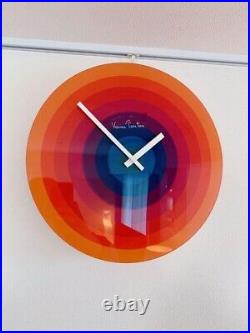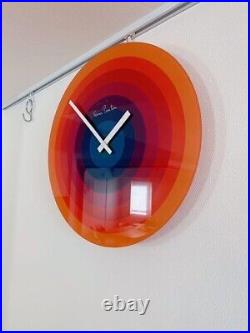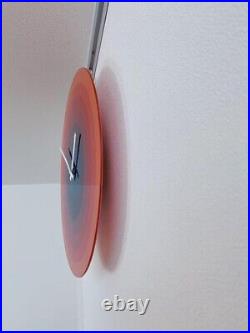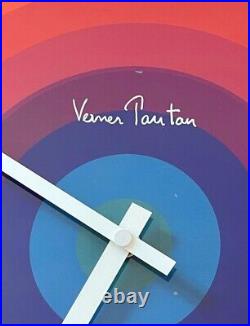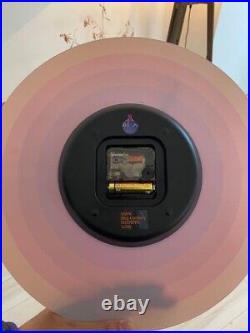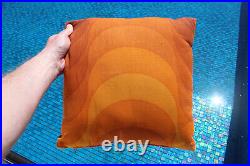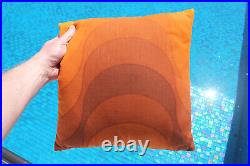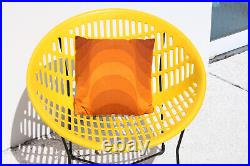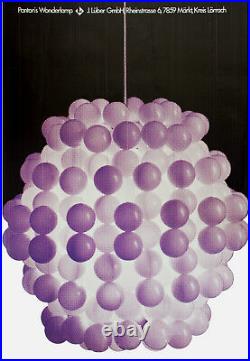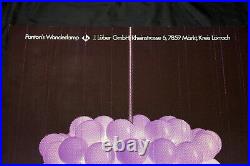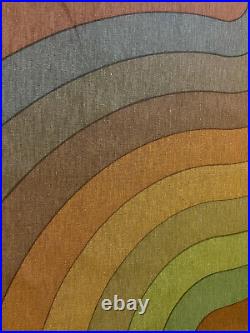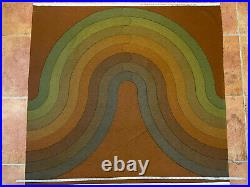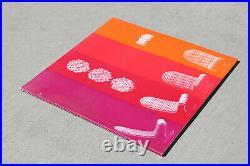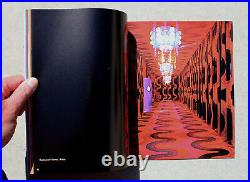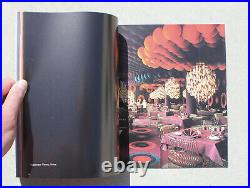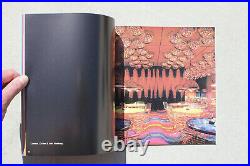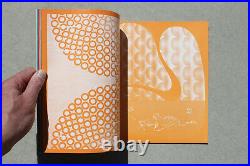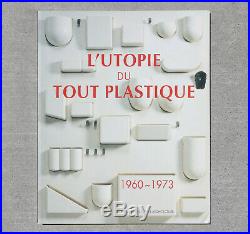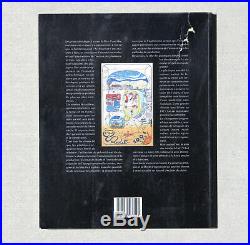

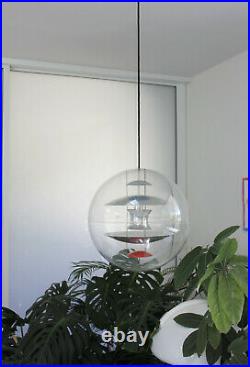


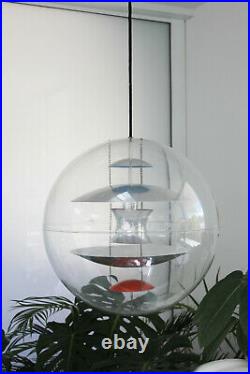
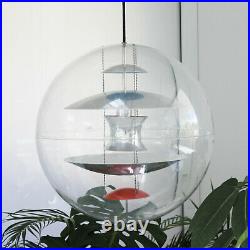


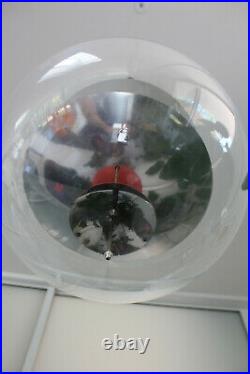
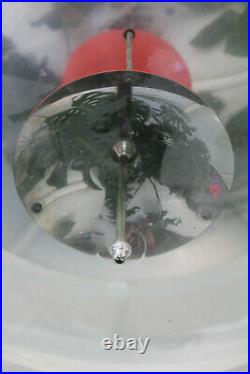
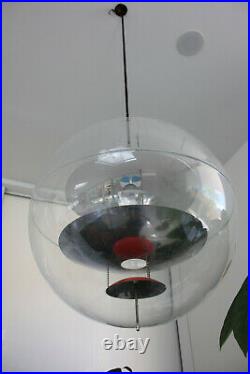
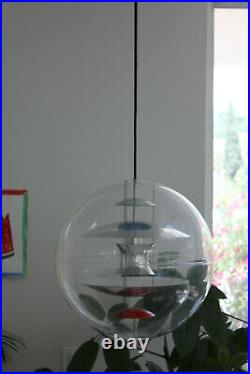

From our Spaceship to yours. No whiners or prima ballerinas please. Verner PANTON’original’ VP-Globe from 1969/70 made by Louis Poulsen in Denmark. This is the large Louis Poulsen VP-Globe measuring 48cm in diameter. Not a new reproduction; this is the original from 1969 made by Louis Poulsen. Second image is a stock image from the Louis Poulsen catalogue from 1970. Other images are of the actual item. Verner Panton original Louis Poulsen VP-Globe re-discovered in my storage after 25 years under a’layer’ of dust. I have cleaned it up but it needs just a little bit more care. Small hairline cracks in the plexiglass. It is missing the ceiling cap. It is missing the original little round ball that that holds the bottom sphere into place. I was able to replace it with a metric European bolt as pictured. It is missing two of the original tiny little clips the hold the metal bead strands on top. I was able to replace them with two copper replacement clips that do the job. The metal bottom bar plus ball chains has oxidation by age. The metal (center of lamp) has some scuffs. Most of the scuffs on the white lacquered metal come out with Novus polishing cream. This is a super fragile lamp so I prefer you pick it up. I prefer you pick it up. You need to have some basic assembly skills. The following is filler nonsense. With a remarkable faith in the unlimited possibilities of forms and materials, he worked successfully to create a new set of theories about how a chair should look and how it should seat someone. Experimenting with every material available, and propelled by the rapidly advancing technology of the production processes, he created a body of work that is astounding for its elegance and for the remarkable diversity of his pieces. He was trained at a technical school in Odense, Denmark as an architectural engineer and then at the Royal Danish Academy of Fine Arts in Copenhagen. He worked in Arne Jacobsen’s architectural office from 1950-52, where it is rumored that he was one of the worst workers, ostensibly because he was preoccupied with his own designs. He started his own design office in 1955 and, in the same year, came out with the tubular steel and woven cane “Bachelor” and “Tivoli” chairs. In 1958 his work as the architect of the Applied Art display at the Fredericia Furniture Fair was a harbinger of his non-traditional approach to the tenets of design. Shocking both attendees and artists, he displayed the furniture by hanging it from the ceiling of the stand. With his 1958 “Cone” chair, and the “Heart” chair the following year, both made of upholstered bent sheet metal, he began to subtly change the structure of the chair. The chairs had no discernible back, and no legs, and resembled a sculpted cylinder into which someone would be inserted. Because his chairs, even from the beginning, rarely had traditional legs, critics at the time suggested that they should be called’seats’ rather than try to imagine them as chairs. He revisited this shape in 1963 with the “Wire Cone” chair. The 1960 stacking “Panton” chair, the first to be produced from a single piece of molded plastic, brought Panton international recognition with its modern and unexpected form. It was first shown at the Mobilia club and awarded an A. The shape of the chair, a single curve with no extraneous skeleton was designed to give a soft, rather than rigid, support and it was made is a range of bright colors. Originally produced by Fritz Hansen, it was later picked up and put into mass production by Herman Miller. Panton’s 1966 “S” chair, produced by Thonet, was similar to the “Panton” in shape and was the first single piece cantilevered chair in plywood. He also expanded this shape into the 1963 “Upholstered Seating System” pieces that were longer, stretched out versions, like a completely relaxed “Panton” chair. This series was inspired by Panton’s philosophy that a set of furniture should interact within itself as a kind of chair landscape, which refuses to be just functional. In the late 1960s and early 1970s Panton experimented with a radical series of upholstered environments. He wanted “to encourage people to use their fantasy and make their surroundings more exciting, ” and to this end created the 1963 “Flying” chair, the 1968 “Pantower, ” an upholstered unit with several levels, and the1974 upholstered Sitting Wheel. ” Two chairs he created for Cassina in 1979, “Sisters Emmenthaler” and the “Mrs. Emmenthaler chaise longue, were more playful and figurative, imitating the shape of the body. Panton is also known for his extraordinarily unique and sculptural lighting in plastic and Capiz shells. He employed shells, UFO-like metal and plastic elements, plastic balls and brightly colored or shiny twisted strands of plastic to forward the philosophy set forth by fellow Dane Poul Henningsen that the design of a lamp should obscure the bulb or light source. Some of his most coveted designs from this time include the “Wonderlamp, ” “VP Globe, ” “Spiral Lampen, ” the “Fun” series and the Flowerpot. The body of work produced by Verner Panton represents one of the most progressive and successful of the 20th century. In 1954 the four Scandinavian countries, Denmark, Sweden, Norway and Finland arranged what proved to be the most important marketing effort ever for Scandinavian designthe monumental exhibition Design in Scandinavia. From 1954 to 1957 Design in Scandinavia toured the United States and Canada. The exhibition was presented in 27 cities, and it was a huge success, initiated by The Danish Society of Arts and Crafts and its sister organizations in the other participating countries. Based on the success the four countries established what they called the Scandinavian Design Cavalcade, which had a lot of US press coverage as well. In that connection the July 1959 issue of House Beautiful was centered around The Scandinavian Look in U. Homes, and it was Denmark and Danish Design in particular that the magazine focussed on. Besides the editorial pages, the numerous ads illustrates that Danish modern furniture was increasingly gaining a stronghold among certain groups of American consumers. Importers and retail chains like John Stuart Inc. George Tanier, Raymor and Dunbar etc. From the end of the 1950s Danish Department stores and other retailers produced comprehensive brochures and booklets in English with prices in US Dollars presenting Danish Design to American and other tourists. Without exception, these stores all presented the narrative of Danish modern. Denmark is known all over the world for its exquisite home furnishing, which are characterized by their outstanding design and superb craftsmanship the department store Magasin claimed in its brochure Danish Design. The item “Rare Louis Poulsen VP-GLOBE Verner PANTON Space Age Mid Century Modern Lamp 60s” is in sale since Wednesday, February 10, 2021. This item is in the category “Collectibles\Vintage, Retro, Mid-Century\1960s”. The seller is “skystays32″ and is located in Sonoma, California. This item can be shipped to United States, Canada, United Kingdom, Denmark, Romania, Slovakia, Bulgaria, Czech republic, Finland, Hungary, Latvia, Lithuania, Malta, Estonia, Australia, Greece, Portugal, Cyprus, Slovenia, Japan, China, Sweden, South Korea, Indonesia, Taiwan, South africa, Thailand, Belgium, France, Hong Kong, Ireland, Netherlands, Poland, Spain, Italy, Germany, Austria, Bahamas, Israel, Mexico, New Zealand, Singapore, Switzerland, Norway, Saudi arabia, Ukraine, United arab emirates, Qatar, Kuwait, Bahrain, Croatia, Malaysia, Brazil, Chile, Colombia, Panama, Jamaica, Barbados, Bangladesh, Bermuda, Brunei darussalam, Bolivia, Ecuador, Egypt, French guiana, Guernsey, Gibraltar, Guadeloupe, Iceland, Jersey, Jordan, Cambodia, Cayman islands, Liechtenstein, Sri lanka, Luxembourg, Monaco, Macao, Martinique, Maldives, Nicaragua, Oman, Peru, Pakistan, Paraguay, Reunion, Viet nam, Uruguay.
- Country/Region of Manufacture: Denmark
- Object Type: Lamp



